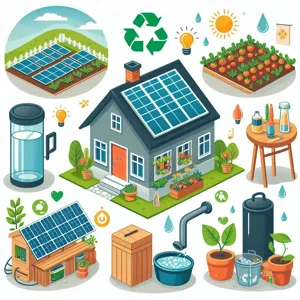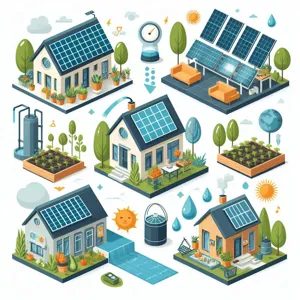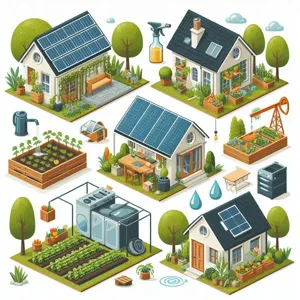As our planet faces increasing environmental challenges, the automotive industry is undergoing a remarkable transformation, with sustainability at its forefront.
The rise of eco-conscious consumers and advancements in sustainability led to a new generation of vehicles that not only promise to reduce our carbon footprint but also offer impressive performance and innovative features. In this blog post, we’ll explore the top 10 sustainable cars that are paving the way for a greener future. From sleek electric vehicles that run entirely on battery power to hybrid models that blend efficiency with traditional engines, these cars embody the perfect balance of style, functionality, and environmental responsibility. Join us on this journey as we dive into the world of sustainable driving, highlighting the best options available for those looking to make a positive impact while cruising in comfort and style.
1. Introduction to Sustainable Cars

As the world grapples with climate change and the pressing need for environmental stewardship, the automotive industry is undergoing a transformative shift towards sustainability. Sustainable cars, often referred to as green or eco-friendly vehicles, are designed with the intent to minimize their environmental impact throughout their lifecycle—from production to disposal. This shift is not merely a trend but a necessity, as consumers increasingly prioritize eco-conscious choices and governments introduce stricter emissions regulations.
Sustainable vehicles come in various forms, including electric cars, hybrids, and hydrogen fuel cell vehicles, each offering unique advantages in reducing greenhouse gas emissions and reliance on fossil fuels. Electric vehicles (EVs), powered entirely by electricity, have surged in popularity due to advancements in battery technology, offering a cleaner alternative to traditional gasoline-powered cars. Hybrids bridge the gap by combining an internal combustion engine with an electric motor, enhancing fuel efficiency while reducing emissions. Meanwhile, hydrogen fuel cell vehicles represent a cutting-edge approach, generating electricity through a chemical reaction between hydrogen and oxygen, with water vapor as the only byproduct.
Beyond their eco-friendly credentials, sustainable cars are also becoming more accessible, with an expanding range of models to suit various lifestyles and budgets. From compact city cars to spacious SUVs, manufacturers are innovating to meet the diverse needs of consumers while adhering to sustainability principles. In this blog post, we will explore the top ten sustainable cars that not only exemplify cutting-edge technology and design but also pave the way for a greener future, encouraging drivers to make environmentally responsible choices without compromising on performance or comfort. Join us as we take a closer look at these remarkable vehicles that are helping to redefine the way we think about transportation and its impact on our planet.
2. The Importance of Sustainability in the Automotive Industry
The automotive industry stands at a pivotal crossroads, where sustainability is no longer just an option but a necessity. As concerns over climate change and environmental degradation escalate, manufacturers and consumers alike are recognizing the critical role that sustainable practices play in shaping a greener future. The importance of sustainability in the automotive sector extends beyond mere compliance with regulations; it encapsulates a holistic approach that prioritizes the planet’s health, societal well-being, and economic viability.
At its core, sustainability in the automotive industry encompasses the entire lifecycle of a vehicle, from production and use to disposal. This means adopting eco-friendly materials, optimizing manufacturing processes to reduce waste and emissions, and designing vehicles that are energy-efficient and have a lower carbon footprint. By utilizing renewable resources, recycling materials, and investing in clean energy technologies, automakers can significantly lessen their environmental impact.
Moreover, the shift towards sustainable transportation is driven by changing consumer preferences. Today’s buyers are increasingly conscious of their ecological footprint and are seeking vehicles that align with their values. This demand for greener options has spurred innovation, leading to advancements in electric and hybrid technologies, as well as the development of alternative fuels. As companies respond to this market trend, sustainability becomes a competitive advantage, attracting environmentally-minded consumers and fostering brand loyalty.
Furthermore, the importance of sustainability transcends individual consumer choices; it has far-reaching implications for public health and urban planning. As electric vehicles become more prevalent, air quality improves, reducing health risks associated with pollution. Additionally, sustainable automotive practices contribute to the creation of smart cities, where efficient transportation systems and green infrastructure work hand in hand to enhance the quality of life for residents.
In summary, the importance of sustainability in the automotive industry is multi-faceted, influencing everything from manufacturing processes to consumer behaviors and societal impacts. As we drive towards a greener future, embracing sustainability is not just an ethical imperative; it is a pathway to innovation and resilience within the industry. Adopting sustainable practices today will not only benefit the planet but also pave the way for a more sustainable and prosperous tomorrow for all.
3. Criteria for Evaluating Sustainability of Cars

When it comes to evaluating sustainable cars, several key criteria must be considered to ensure that the vehicle not only minimizes environmental impact but also meets the practical needs of the driver. Here’s a closer look at the primary factors that should influence your decision when choosing a sustainable vehicle:
1. **Fuel Efficiency**: One of the most critical indicators of a sustainable car is its fuel efficiency, measured in miles per gallon (MPG) or electric range. Higher efficiency means fewer emissions and a lower carbon footprint, making it essential to consider how far a vehicle can travel on a gallon of fuel or a full charge.
2. **Emissions**: The type of emissions a car produces is pivotal in determining its sustainability. Look for vehicles that produce low or zero emissions, such as electric cars (EVs), plug-in hybrids, or those powered by alternative fuels like hydrogen. Checking the vehicle’s emissions rating can provide insight into its environmental impact.
3. **Materials and Manufacturing**: Sustainable cars should be made from eco-friendly materials and manufactured in environments that prioritize sustainable practices. This includes using recycled materials, responsible sourcing, and efficient production methods that reduce waste and energy consumption.
4. **Lifecycle Impact**: It’s essential to consider the entire lifecycle of the vehicle, from production through to disposal. Assessing how the car will be recycled or disposed of at the end of its life can provide a clearer picture of its overall sustainability.
5. **Technological Innovations**: Many sustainable cars come equipped with advanced technologies designed to enhance efficiency and reduce emissions. Features like regenerative braking, smart energy management systems, and eco-driving modes can all contribute to a greener driving experience.
6. **Certifications**: Look for industry certifications or ratings from recognized organizations that evaluate the sustainability of vehicles. Certifications such as the EPA’s Energy Star label or the Green Vehicle Guide can help you identify truly sustainable options.
7. **Cost of Ownership**: Finally, consider the total cost of ownership, which includes not just the purchase price but also fuel costs, maintenance, insurance, and potential tax incentives for eco-friendly vehicles. A higher upfront cost might be offset by long-term savings, making sustainable choices more economically viable.
By systematically evaluating these criteria, potential buyers can make informed decisions that align with their values and contribute to a greener future. The transition to sustainable transportation is not just about choosing the right car; it’s about embracing a mindset that prioritizes environmental responsibility and innovation.
4. Overview of Electric Vehicles (EVs)
As we shift towards a more sustainable future, electric vehicles (EVs) stand out as a beacon of innovation and environmental responsibility. Unlike traditional internal combustion engines, which emit harmful pollutants and greenhouse gases, EVs operate on electric power stored in rechargeable batteries, significantly reducing their carbon footprint. This shift not only contributes to cleaner air but also lessens our reliance on fossil fuels, marking a pivotal step in combating climate change.
The technology behind EVs has advanced at a remarkable pace, leading to improvements in battery efficiency and charging infrastructure. Modern electric vehicles offer impressive ranges, with many models capable of traveling over 300 miles on a single charge, alleviating the range anxiety that once plagued potential buyers. Moreover, the growing network of charging stations—ranging from fast chargers at public locations to home charging solutions—has made it easier than ever for drivers to go electric without compromising convenience.
Beyond their ecological benefits, EVs are increasingly recognized for their performance. With instant torque and quiet operation, electric engines deliver a smooth and exhilarating driving experience, often outperforming their gasoline counterparts in acceleration and handling. Brands like Tesla, Nissan, and Chevrolet have led the charge, but the market is rapidly expanding, with traditional automakers like Ford, Volkswagen, and BMW unveiling their own cutting-edge electric models.
As consumers become more environmentally conscious, the demand for electric vehicles continues to rise. Many governments around the world are incentivizing the adoption of EVs through tax rebates, grants, and subsidies, further encouraging a transition away from gas-powered vehicles. This shift is not just about individual choices; it represents a collective movement toward sustainable transportation that can pave the way for a healthier planet.
In summary, electric vehicles are not just a trend; they are a crucial part of the solution to many of the environmental challenges we face today. With their eco-friendly technology, impressive performance, and growing availability, EVs are driving us toward a greener future—one charge at a time.
5. Hybrid Cars: Bridging the Gap

Hybrid cars represent a pivotal innovation in the automotive industry, effectively bridging the gap between traditional gasoline-powered vehicles and fully electric alternatives. These vehicles combine a conventional internal combustion engine with an electric motor, allowing them to harness the benefits of both power sources. This duality not only enhances fuel efficiency but also reduces harmful emissions, making hybrids an attractive option for eco-conscious drivers who may not be ready to fully commit to electric vehicles.
One of the most appealing aspects of hybrid cars is their ability to seamlessly switch between the gas engine and electric motor, optimizing performance based on driving conditions. Whether you’re navigating through city traffic or cruising on the highway, hybrids adjust their power sources to deliver a smooth and efficient ride. This feature is particularly beneficial for urban drivers, as hybrids often operate on electric power at low speeds, minimizing emissions during short trips.
Moreover, hybrid models have come a long way in terms of design and technology. From sleek sedans to versatile SUVs, consumers are presented with a wide range of options that cater to various lifestyles and preferences. Many of today’s hybrid vehicles also boast advanced regenerative braking systems that capture and store energy typically lost during braking, further enhancing fuel efficiency.
As the demand for sustainable transportation continues to rise, automakers are increasingly investing in hybrid technology, leading to improvements in battery life, charging times, and overall performance. This ongoing evolution not only makes hybrids more appealing to the average consumer but also reinforces their role as a crucial stepping stone toward a greener future in mobility. By choosing a hybrid car, drivers can enjoy the best of both worlds—reduced environmental impact without compromising the convenience and familiarity of conventional driving.
6. Plug-in Hybrid Electric Vehicles (PHEVs)
Plug-in Hybrid Electric Vehicles (PHEVs) represent a transformative step in the automotive industry’s quest for sustainability. These innovative vehicles combine the benefits of both traditional gasoline engines and electric power, offering drivers the best of both worlds. With a PHEV, you can enjoy the flexibility of a gasoline engine for longer journeys while relying on electric power for shorter trips, effectively reducing your carbon footprint.
What sets PHEVs apart is their dual power sources. Equipped with a substantial battery that can be charged via a standard electrical outlet or a dedicated charging station, these vehicles allow for extended all-electric driving ranges. Many models boast an electric-only range of 20 to 50 miles, making them ideal for daily commutes or errands, while seamlessly switching to gasoline for longer excursions. This clever integration means that drivers can significantly reduce fuel consumption and greenhouse gas emissions, particularly in urban settings where short trips are common.
Moreover, PHEVs often come with advanced regenerative braking systems, which harness energy during braking and feed it back into the battery, further enhancing efficiency. As technology evolves, many manufacturers are incorporating sophisticated energy management systems that optimize the use of electricity and gasoline, ensuring that drivers make the most of their vehicle’s capabilities.
In terms of convenience, PHEVs offer a unique advantage: they can be refueled at any gas station, alleviating concerns over charging infrastructure while still promoting a greener driving experience. Many models also qualify for government incentives, making them not only an environmentally friendly choice but also a financially savvy one.
As we collectively strive for a more sustainable future, Plug-in Hybrid Electric Vehicles stand out as a practical solution, enabling drivers to transition toward greener practices without sacrificing convenience or performance. With a growing number of manufacturers entering the PHEV market, consumers have an expanding array of options to choose from, making it easier than ever to drive into a cleaner, more sustainable future.
7. Top 10 Sustainable Cars of 2023

As we navigate the path towards a more sustainable future, the automotive industry has made significant strides in producing vehicles that are not only environmentally friendly but also packed with innovative technology and impressive performance. Here’s a closer look at the top 10 sustainable cars of 2023, each representing a unique blend of efficiency, style, and eco-consciousness.
1. **Tesla Model 3**: Known for its cutting-edge electric technology, the Tesla Model 3 continues to dominate the EV market. With a sleek design, impressive range of up to 358 miles, and rapid acceleration, this electric sedan proves that sustainability can coexist with performance.
2. **Ford Mustang Mach-E**: The Mustang Mach-E redefines the iconic muscle car ethos for the electric age. With its bold styling, spacious interior, and a range of up to 300 miles, this SUV offers a thrilling drive while reducing your carbon footprint.
3. **Hyundai Ioniq 5**: With its futuristic design and advanced technology, the Hyundai Ioniq 5 is a standout in the electric vehicle segment. Its spacious interior, rapid charging capabilities, and impressive range make it an excellent choice for eco-conscious drivers.
4. **Toyota Prius Prime**: The Prius Prime combines the best of both worlds with its plug-in hybrid technology. This car offers the flexibility of electric driving for short trips while retaining the efficiency of a traditional hybrid for longer journeys, making it a versatile option for all types of drivers.
5. **BMW i4**: The BMW i4 is a luxurious electric sedan that delivers a dynamic driving experience. With a sporty design and powerful electric motors, it offers both performance and sustainability, achieving a remarkable range of approximately 300 miles on a single charge.
6. **Rivian R1T**: Pioneering the electric truck segment, the Rivian R1T blends rugged capability with sustainable engineering. It boasts impressive off-road performance, a spacious interior, and a range of over 300 miles, making it perfect for adventure seekers who prioritize sustainability.
7. **Nissan Leaf**: A pioneer in the electric vehicle market, the Nissan Leaf remains a practical and affordable option for eco-conscious drivers. With a range of up to 226 miles and a reputation for reliability, it continues to be a popular choice for everyday commuting.
8. **Kia EV6**: The Kia EV6 is a stylish and dynamic electric crossover that has quickly gained attention for its fast charging and impressive range. With sleek lines and a spacious interior, it offers a comfortable ride while championing sustainability.
9. **Volvo XC40 Recharge**: Combining luxury with eco-friendliness, the Volvo XC40 Recharge is an all-electric SUV that emphasizes safety and sustainability. Its stylish design, advanced safety features, and impressive performance make it a top contender in the sustainable vehicle market.
10. **Lucid Air**: Representing the pinnacle of luxury electric vehicles, the Lucid Air offers a remarkable range of over 500 miles, luxurious interiors, and cutting-edge technology. With its focus on performance and sustainability, it sets a new standard for high-end electric driving.
These ten sustainable cars of 2023 illustrate the automotive industry’s commitment to a greener future. As consumers become more environmentally conscious, the demand for these innovative vehicles will only grow, paving the way for a cleaner, more sustainable world on wheels. Whether you’re looking for an efficient commuter, a family-friendly SUV, or a luxury sedan,
– 1. Tesla Model 3
The Tesla Model 3 stands as a beacon of innovation in the electric vehicle landscape, blending sustainability with cutting-edge technology. With its sleek aerodynamic design and minimalist interior, the Model 3 not only captivates the eye but also exemplifies Tesla’s commitment to reducing carbon emissions.
Equipped with an impressive electric range of over 350 miles on a single charge, this compact sedan ensures that drivers can embark on long journeys without the frequent worry of finding a charging station. The Model 3’s high-efficiency powertrain accelerates from 0 to 60 mph in just over 3 seconds in its Performance variant, delivering a thrilling driving experience while remaining entirely emissions-free.
Inside, the Model 3 features a spacious cabin dominated by a 15-inch touchscreen that controls nearly all vehicle functions, from navigation to climate control. This intuitive interface enhances the driving experience while minimizing distractions, allowing drivers to focus on the road ahead. The vehicle also comes equipped with advanced safety features, earning it top ratings in crash tests and making it one of the safest cars on the market.
Furthermore, Tesla’s commitment to sustainability extends beyond the vehicle itself. By utilizing a vast network of Superchargers powered by renewable energy sources, Tesla aims to create a sustainable ecosystem for electric vehicle users. The Model 3 is not just a car; it’s a step towards a greener future, encouraging drivers to embrace a more environmentally friendly lifestyle while enjoying the perks of modern technology. With its combination of performance, safety, and sustainability, the Tesla Model 3 is a frontrunner in the race for a cleaner, more sustainable automotive world.
– 2. Toyota Prius
The Toyota Prius has long held its position as a pioneer in the world of sustainable vehicles, often regarded as the face of hybrid technology since its debut in the late 1990s. This iconic hatchback is synonymous with fuel efficiency, boasting a remarkable EPA-estimated 56 miles per gallon combined, making it an ideal choice for eco-conscious drivers looking to reduce their carbon footprint without sacrificing practicality.
The Prius’s sleek, aerodynamic design not only enhances its aesthetic appeal but also plays a crucial role in its efficiency. With a low drag coefficient, the vehicle glides through the air with minimal resistance, maximizing fuel economy. Inside, the Prius is equipped with a spacious cabin, innovative technology, and user-friendly features, all designed to provide comfort and convenience for both driver and passengers. The intuitive infotainment system, complete with a touchscreen display and smartphone integration, ensures that drivers stay connected while on the go.
What truly sets the Prius apart, however, is its commitment to sustainability. The vehicle is constructed using eco-friendly materials, and Toyota has implemented various recycling programs to reduce waste during the manufacturing process. Additionally, the Prius is available in a plug-in hybrid variant, the Prius Prime, which allows for even greater electric-only driving range, further minimizing reliance on fossil fuels.
As cities worldwide push for greener transportation solutions, the Toyota Prius remains a steadfast choice for those seeking to embrace a more sustainable lifestyle. With its blend of efficiency, practicality, and commitment to environmental responsibility, the Prius is not just a car; it’s a statement of intent towards a greener future. Whether you’re navigating bustling urban streets or cruising along scenic highways, the Toyota Prius proves that eco-friendly driving can indeed be both stylish and responsible.
– 3. Ford Mustang Mach-E
The Ford Mustang Mach-E has emerged as a true trailblazer in the realm of sustainable vehicles, combining the iconic spirit of the Mustang with cutting-edge electric technology. This all-electric SUV is not just a nod to its legendary predecessor; it redefines what a Mustang can be while championing eco-friendliness.
With a sleek, aerodynamic design that turns heads, the Mach-E boasts a modern aesthetic complemented by an expansive interior space that prioritizes comfort and functionality. Inside, drivers and passengers are greeted by a futuristic dashboard equipped with a large touchscreen display that seamlessly integrates Ford’s advanced SYNC infotainment system. This system provides real-time updates, navigation, and a host of connectivity options, ensuring that every journey is as enjoyable as it is efficient.
Under the hood, the Mach-E offers a variety of powertrain options, allowing customers to choose the model that best suits their driving style. With a range of up to 300 miles on a single charge, this electric vehicle alleviates the common concerns associated with range anxiety. Plus, the impressive acceleration—from 0 to 60 mph in as little as 3.5 seconds—ensures that it delivers the performance enthusiasts have come to expect from the Mustang name.
Ford has also prioritized sustainability in the Mach-E’s production process. The vehicle is built with recycled materials and incorporates innovative manufacturing techniques designed to minimize environmental impact. By opting for the Mach-E, drivers are not only enjoying a thrilling ride but are also actively participating in the movement toward a cleaner, greener future.
In summary, the Ford Mustang Mach-E is not just an electric vehicle; it’s a statement of intent. It embodies a commitment to sustainability without compromising performance or style, making it a standout choice in the ever-evolving landscape of eco-friendly cars. For those looking to embrace the future of driving, the Mach-E is undoubtedly a top contender.
– 4. Hyundai Ioniq 5
The Hyundai Ioniq 5 has emerged as a standout player in the realm of sustainable vehicles, seamlessly blending cutting-edge technology with eco-friendly design. This all-electric crossover showcases a striking, futuristic aesthetic, characterized by its sleek lines, bold front fascia, and distinctive pixelated light clusters that set it apart on the road. But it’s not just about looks; the Ioniq 5 is built on Hyundai’s dedicated Electric-Global Modular Platform (E-GMP), designed specifically for electric vehicles, which contributes to its spacious interior and impressive performance.
Under the hood, the Ioniq 5 offers a range of powertrain options, providing drivers with the choice between a standard and long-range battery, along with various configurations that can deliver up to 320 miles on a single charge. This impressive range is complemented by rapid charging capabilities, allowing the Ioniq 5 to go from 10% to 80% battery in just 18 minutes at a fast-charging station—perfect for those on the go.
Inside the cabin, sustainability meets sophistication. The Ioniq 5 is crafted using eco-friendly materials, including recycled plastics and sustainable fabrics, ensuring that its luxurious feel doesn’t come at the expense of the planet. The spacious interior is designed with the driver in mind, featuring a digital cockpit, a large touchscreen interface, and advanced connectivity options that make every journey not only enjoyable but also user-friendly.
Safety is another hallmark of the Ioniq 5, equipped with Hyundai’s latest SmartSense safety features which include adaptive cruise control, lane-keeping assist, and a comprehensive suite of driver-assistance technologies. With its impressive performance, sustainable design, and commitment to safety, the Hyundai Ioniq 5 is not just a car; it’s a statement of intent towards a greener future, making it a top contender in the world of sustainable automobiles. As more drivers seek to minimize their environmental impact, the Ioniq 5 stands ready to meet that demand, proving that driving sustainably doesn’t mean sacrificing style or comfort.
– 5. Nissan Leaf
The Nissan Leaf has emerged as a pioneer in the electric vehicle (EV) landscape, embodying the essence of sustainability while delivering a practical driving experience. Launched in 2010, the Leaf quickly gained recognition as one of the best-selling electric cars in the world, thanks to its user-friendly design, impressive range, and affordability.
With its sleek, aerodynamic silhouette, the Leaf is not just an eco-friendly option; it also offers a contemporary aesthetic that appeals to modern drivers. Under the hood, the Leaf is powered by an advanced electric motor that delivers a smooth, silent ride while producing zero tailpipe emissions. Its latest model boasts an impressive range of up to 226 miles on a single charge, making it an ideal choice for both city commutes and longer journeys.
Inside, the Nissan Leaf is equipped with a spacious interior that comfortably seats five passengers and provides ample cargo space, making it perfect for families or those who require extra room for gear. The cabin is laden with technology, featuring an intuitive infotainment system that supports smartphone integration, allowing drivers to access navigation, music, and hands-free calling seamlessly.
Moreover, Nissan has made strides in sustainability by utilizing recycled materials in the Leaf’s construction and promoting responsible manufacturing practices. The brand is committed to reducing its carbon footprint, and the Leaf is a key player in this mission, representing a step towards a more sustainable automotive future.
What truly sets the Leaf apart is its commitment to innovation. With features like ProPILOT Assist, which offers semi-autonomous driving capabilities, and e-Pedal technology, allowing drivers to accelerate and decelerate using only one pedal, the Nissan Leaf is not just a car; it’s a glimpse into the future of driving.
As consumers increasingly prioritize sustainability, the Nissan Leaf stands out as a symbol of how electric vehicles can lead us towards a greener future while providing practicality and enjoyment on the road.
– 6. BMW i4
The BMW i4 marks a significant step in the automaker’s journey toward electrification, combining the brand’s signature performance with a commitment to sustainability. This sleek, all-electric Gran Coupe embodies a perfect blend of luxury and eco-friendliness, making it a standout in the sustainable vehicle market. With its dynamic silhouette and aerodynamic design, the i4 not only turns heads but also enhances efficiency, allowing for an impressive range of up to 300 miles on a single charge, depending on the variant.
Under the hood, the i4 boasts powerful electric motors that deliver exhilarating acceleration, propelling the car from 0 to 60 mph in just 3.7 seconds in the performance-focused i4 M50 model. This impressive performance does not come at the cost of comfort or luxury. Inside, the i4 is adorned with high-quality materials and cutting-edge technology, including a large curved display that seamlessly integrates the instrument cluster with the infotainment system, providing an intuitive driving experience.
Sustainability is at the forefront of the BMW i4’s design. The vehicle is constructed using a significant percentage of recycled materials, and its production process incorporates green energy sources, minimizing its carbon footprint. Additionally, BMW’s commitment to responsible sourcing ensures that the raw materials used, such as lithium for the battery, are obtained ethically and sustainably.
With features like regenerative braking, which converts kinetic energy back into stored energy while driving, the i4 maximizes efficiency and extends battery life. The BMW i4 is not just a car; it’s a statement that driving towards a greener future can be done without sacrificing the thrill of driving. As more consumers seek sustainable alternatives in the automotive market, the i4 stands out as a testament to innovation, performance, and environmental responsibility.
– 7. Kia EV6
The Kia EV6 stands as a beacon of modern electric mobility, seamlessly blending style, performance, and sustainability. This striking crossover SUV marks a significant step for Kia into the world of electric vehicles, showcasing their commitment to a greener future while offering an exhilarating driving experience.
With its sleek, aerodynamic design, the EV6 commands attention on the road. Its bold lines and futuristic profile not only make a statement but also enhance its efficiency by reducing drag. Inside, the cabin is a sanctuary of modernity, featuring eco-friendly materials and cutting-edge technology that emphasizes both comfort and sustainability. The spacious interior is designed with the driver in mind, boasting an intuitive infotainment system that keeps you connected and informed while minimizing distractions.
Under the hood, the EV6 offers impressive performance metrics that rival many traditional gas-powered vehicles. With multiple variants available, including all-wheel drive options, drivers can choose the balance of power and efficiency that suits their lifestyle. The EV6’s impressive range—up to approximately 300 miles on a single charge—means you can embark on longer journeys with confidence, and its rapid charging capabilities allow you to recharge to 80% in just 18 minutes at a fast-charging station.
Moreover, Kia has integrated a suite of advanced safety features into the EV6, ensuring that both driver and passengers can enjoy peace of mind on every journey. From adaptive cruise control to lane-keeping assist, these technologies not only enhance safety but also contribute to a more relaxed driving experience.
In a world increasingly focused on sustainability, the Kia EV6 emerges as an exemplary model for those looking to reduce their carbon footprint without sacrificing performance or style. With its combination of innovative design, cutting-edge technology, and eco-friendly engineering, the EV6 exemplifies what it means to drive towards a greener future, making it a compelling choice for environmentally-conscious consumers.
– 8. Volkswagen ID.4
The Volkswagen ID.4 marks a significant stride in the automaker’s transition to a sustainable future, embodying a harmonious blend of innovation, performance, and eco-friendliness. As Volkswagen’s first all-electric SUV, the ID.4 showcases the brand’s commitment to reducing its carbon footprint while offering consumers a practical yet stylish vehicle.
This electric powerhouse features a sleek, aerodynamic design that not only turns heads but also enhances its efficiency on the road. With a spacious interior that comfortably seats five, the ID.4 provides ample legroom and cargo space, making it a perfect choice for families and adventurers alike. The minimalist dashboard is equipped with a user-friendly infotainment system, ensuring that drivers stay connected without compromising focus on the road ahead.
Under the hood, the ID.4 is powered by a robust electric motor that delivers impressive torque and quick acceleration, allowing drivers to experience the thrill of responsive handling while enjoying the benefits of zero tailpipe emissions. With an estimated range of up to 250 miles on a single charge, this SUV is not only suitable for daily commutes but also long road trips, reinforcing the notion that electric vehicles can seamlessly fit into modern lifestyles.
Volkswagen has also prioritized sustainability in the materials used throughout the ID.4’s construction. From recyclable plastics to responsibly sourced fabrics, every aspect of this vehicle reflects a commitment to reducing environmental impact. Additionally, the brand’s ambitious plans to expand its EV lineup and invest in renewable energy further solidify the ID.4’s role in driving the automotive industry toward a greener future.
In summary, the Volkswagen ID.4 stands out as a remarkable option for eco-conscious consumers who seek a versatile, stylish, and efficient SUV. Its combination of performance, spaciousness, and a commitment to sustainability makes it a compelling choice in the ever-evolving landscape of electric vehicles. As we navigate toward a greener future, the ID.4 is not just a car; it’s a statement of intent for a more sustainable way of driving.
– 9. Chevrolet Bolt EV
The Chevrolet Bolt EV stands as a beacon of innovation in the world of electric vehicles, combining affordability with impressive range and functionality. Launched as a game-changer for eco-conscious drivers, the Bolt EV offers a spacious interior, cutting-edge technology, and a robust battery that propels it to the forefront of sustainable driving.
With an estimated range of over 250 miles on a single charge, the Bolt EV alleviates the common concerns surrounding electric vehicle range anxiety. This remarkable distance allows drivers to embark on longer journeys without the constant worry of finding a charging station. Plus, its efficient electric motor produces zero tailpipe emissions, making it an ideal choice for those dedicated to reducing their carbon footprint.
Inside, the Bolt EV surprises with its roomy cabin and cargo space, accommodating both passengers and their gear with ease. The intuitive infotainment system, featuring a large touchscreen display, offers seamless connectivity with smartphone integration through Apple CarPlay and Android Auto. This ensures that drivers remain connected on the go while enjoying the benefits of an eco-friendly vehicle.
Moreover, Chevrolet has made strides in sustainability beyond just the vehicle itself. The production process for the Bolt EV emphasizes eco-friendly practices, including the use of renewable energy and sustainable materials. This commitment to sustainability resonates with environmentally conscious consumers who are not only interested in the car’s performance but also in its overall impact on the planet.
In summary, the Chevrolet Bolt EV is not just a car; it’s a commitment to a greener future. With its blend of practicality, advanced technology, and environmental consciousness, it serves as an excellent choice for anyone looking to make a positive change in the way they drive. As we steer towards a more sustainable future, the Bolt EV stands out as a testament to what is possible in the realm of electric vehicles.
– 10. Subaru Solterra
The Subaru Solterra is a remarkable addition to the electric vehicle landscape, embodying the brand’s commitment to sustainability while maintaining the rugged reliability that Subaru enthusiasts have come to love. This all-electric SUV is a testament to the evolution of environmentally friendly driving, designed for those who refuse to compromise on performance or utility.
With a sleek and modern design, the Solterra boasts a spacious interior that comfortably accommodates both passengers and cargo, making it an ideal choice for adventurous families. Its all-wheel-drive capability ensures that it can tackle a variety of terrains, echoing Subaru’s off-road heritage. The Solterra is equipped with a powerful electric drivetrain that provides instant torque, delivering a responsive driving experience while promoting zero emissions.
One of the standout features of the Solterra is its dedication to sustainability. Subaru has crafted this vehicle with eco-friendly materials and practices, including recycled and renewable resources throughout its construction. The Solterra also comes with an impressive range, allowing drivers to embark on longer journeys with confidence, all while reducing their carbon footprint.
Moreover, the Solterra is packed with advanced technology, including a suite of safety features and a user-friendly infotainment system that keeps drivers connected and informed. With its commitment to sustainable driving and high-performance capabilities, the Subaru Solterra is a forward-thinking vehicle that perfectly aligns with the growing demand for greener transportation options. As you consider your next vehicle, the Solterra stands out not just as a car, but as a step towards a more sustainable future.
8. Innovations in Sustainable Automotive Technology
As the automotive industry accelerates towards a greener future, innovations in sustainable automotive technology are transforming the way we think about transportation. Advances in electric vehicle (EV) technology have become a cornerstone of this evolution, with manufacturers developing high-efficiency batteries that offer longer ranges and faster charging times. For instance, the introduction of solid-state batteries promises to significantly enhance energy density and safety, marking a leap forward from traditional lithium-ion batteries.
Moreover, automakers are exploring alternative energy sources beyond electricity. Hydrogen fuel cell vehicles are gaining traction, utilizing hydrogen to produce electricity, emitting only water vapor as a byproduct. This clean energy solution holds immense potential, especially as infrastructure for hydrogen refueling continues to develop.
Additionally, the integration of smart technology into vehicles plays a crucial role in promoting sustainability. Advanced driver-assistance systems (ADAS) and artificial intelligence are enhancing fuel efficiency by optimizing routes and minimizing energy consumption in real-time. These technologies not only reduce emissions but also improve safety on the roads.
Manufacturers are also increasingly focusing on sustainable materials, sourcing components from recycled or renewable resources. Interior features crafted from biodegradable materials or reclaimed plastics are becoming more common, reflecting a commitment to reducing the environmental impact of the entire vehicle lifecycle.
Together, these innovations are driving a significant shift in the automotive landscape. As consumers become more environmentally conscious, the demand for sustainable vehicles is surging. With continuous advancements in technology and a growing commitment to sustainability, the automotive industry is well on its way to creating a cleaner, greener future for all.
9. The Future of Sustainability in Transportation
As we look ahead to the future of sustainable transportation, it becomes clear that innovation and environmental responsibility are at the forefront of the automotive industry’s evolution. Electric vehicles (EVs) are no longer a niche market; they are rapidly becoming mainstream, with manufacturers investing heavily in battery technology and charging infrastructure. This shift is not just a trend but a fundamental change in how we think about mobility.
In the coming years, we can expect to see advancements in autonomous driving technology that will integrate seamlessly with sustainable practices. Imagine a world where self-driving cars operate on shared networks, reducing the number of vehicles on the road and minimizing congestion while utilizing clean energy sources. This could lead to a significant reduction in greenhouse gas emissions, making our streets cleaner and our air fresher.
Moreover, the concept of circular economy is gaining traction within the automotive sector. Manufacturers are exploring eco-friendly materials, recycling old car parts, and adopting sustainable production processes that minimize waste. From bio-based plastics to recycled metals, the materials of tomorrow’s vehicles will play a vital role in reducing their overall environmental footprint.
Public transportation is also set to undergo a transformation, with cities investing in electric buses and rail systems powered by renewable energy. The integration of smart technology will enhance the efficiency of these systems, encouraging more people to choose mass transit over personal vehicles, thus further contributing to a greener urban environment.
As we drive towards this greener future, it’s essential for consumers to recognize their role in this evolution. By choosing sustainable options and supporting eco-friendly initiatives, we can collectively shape the future of transportation. With every electric vehicle purchased, every public transport ticket used, and every sustainable choice made, we’re taking steps toward a more sustainable world—one where the air is cleaner, the streets are quieter, and the planet is healthier for generations to come.
10. How to Choose the Right Sustainable Car for You
Choosing the right sustainable car for your lifestyle can feel like a daunting task, especially with the plethora of options now available on the market. However, with a little guidance, you can navigate this exciting journey toward a greener future.
First and foremost, consider your driving habits. If you’re someone who primarily commutes short distances, a battery electric vehicle (BEV) may be the ideal choice for you. These vehicles run solely on electricity, producing zero tailpipe emissions, and are perfect for zipping around town. On the other hand, if you frequently embark on longer road trips or live in an area with limited charging infrastructure, a plug-in hybrid electric vehicle (PHEV) might be a better fit. PHEVs combine a gasoline engine with an electric motor, offering the flexibility to switch between power sources.
Next, think about your budget. Sustainable cars come in a variety of price ranges, so it’s essential to assess what you can afford. While some models may come with a higher upfront cost, keep in mind that many offer substantial savings in fuel and maintenance over time. Additionally, many governments provide incentives, tax credits, or rebates for eco-friendly vehicles, which could help ease the financial burden.
Do your research on the environmental impact of each model. Look for cars that boast high energy efficiency ratings and utilize sustainable materials in their manufacturing processes. Some manufacturers even prioritize carbon neutrality throughout their supply chains, which can add an extra layer of sustainability to your purchase.
Lastly, take into account the features that matter most to you. Whether it’s advanced safety technology, infotainment systems, or spacious interiors, ensure that the car you choose aligns with your needs. Visit dealerships to take test drives and get a feel for how each vehicle handles. Engaging with current owners through forums or social media can also provide invaluable insights into the day-to-day performance of various sustainable models.
In summary, choosing the right sustainable car involves evaluating your driving habits, budget, environmental considerations, and personal preferences. By taking the time to make an informed decision, you’ll not only contribute to a greener planet but also enjoy the many benefits of driving a vehicle that aligns with your values. Embrace the journey and drive towards a sustainable future!
11. Government Incentives and Rebates for Sustainability
As the world shifts its focus towards sustainable living, governments across the globe are stepping up to encourage eco-friendly practices, particularly when it comes to transportation. One of the most effective ways they’re doing this is through a range of incentives and rebates designed to make sustainable cars more accessible and appealing to consumers.
These incentives can come in various forms, from substantial tax credits for electric vehicle (EV) buyers to cash rebates that reduce the upfront cost of purchasing a hybrid or zero-emissions vehicle. In the United States, for example, federal tax credits can offer up to $7,500 off the purchase of qualifying electric vehicles, significantly easing the financial burden for potential buyers. Additionally, many states offer their own rebates, which can complement federal incentives, leading to even greater savings.
Beyond direct financial incentives, governments may also provide perks such as reduced registration fees, exemptions from tolls, and access to carpool lanes, making sustainable cars not only more economical but also more convenient for daily use. Some cities have taken it a step further by implementing programs that allow EV drivers to charge their vehicles for free in designated areas, further encouraging the transition to greener alternatives.
However, it’s essential to stay informed about the specific incentives available in your region, as they can vary widely based on local laws and regulations. Many government websites provide updated lists of available rebates, allowing consumers to calculate potential savings before making their purchase.
By taking advantage of these incentives, prospective car buyers can significantly lower their costs while contributing to a more sustainable future. Investing in a sustainable vehicle not only positions you at the forefront of automotive innovation but also allows you to participate actively in the global effort to reduce carbon emissions and combat climate change. So, as you consider your next vehicle purchase, remember to explore the incentives that can help pave the way toward a greener and more sustainable driving experience.
12. The Role of Charging Infrastructure in EV Adoption
As electric vehicles (EVs) continue to gain traction in the automotive market, the role of charging infrastructure has emerged as a crucial factor in their widespread adoption. Imagine a world where the convenience of charging your car is as seamless as refueling a traditional gas vehicle—this is the vision driving the expansion of charging networks across cities and highways.
Charging stations are rapidly popping up in urban areas, shopping centers, and along major travel routes, transforming the landscape of our daily commutes and road trips. However, the effectiveness of this infrastructure goes beyond mere availability; it’s about accessibility, reliability, and speed. Fast chargers that can replenish an EV’s battery in a matter of minutes are becoming more common, allowing drivers to make pit stops without significant delays.
Additionally, the integration of charging points into existing infrastructure, such as parking lots and public facilities, is essential for encouraging EV adoption. The more convenient and visible these charging stations are, the more likely potential EV owners will feel confident in making the switch.
Moreover, advancements in technology are paving the way for innovative solutions like wireless charging and smart charging systems that can optimize energy use and reduce costs for consumers. As we move towards a greener future, collaboration between governments, private companies, and local communities will be key to creating a robust network of charging options that makes driving electric not just an eco-friendly choice, but a practical one as well.
In summation, the growth of charging infrastructure is not just a supporting player in the electric vehicle revolution; it’s a game-changer that will shape the landscape of sustainable transportation for years to come. Ensuring that this infrastructure is widespread, reliable, and efficient is crucial for breaking down the barriers to EV adoption and driving us toward a greener, more sustainable future.
13. Conclusion: Driving Towards a Greener Future
As we steer towards a more sustainable future, the choice of vehicle plays a crucial role in our collective journey toward environmental responsibility. The evolution of the automotive industry has brought forth an impressive lineup of sustainable cars that not only reduce our carbon footprint but also enhance our driving experience. From fully electric models that promise zero emissions to hybrid vehicles that ingeniously blend power and efficiency, the options available today are as diverse as they are innovative.
In presenting our top 10 sustainable cars, we’ve highlighted vehicles that not only embody cutting-edge technology and design but also prioritize fuel efficiency and eco-friendliness. These cars represent a shift in consumer consciousness, as more drivers recognize the importance of making choices that benefit both their wallets and the planet. Embracing sustainable vehicles is not just a trend; it’s a necessary adaptation to the pressing challenges of climate change and resource depletion.
As we conclude our exploration, it’s essential to remember that every small decision contributes to a larger impact. Choosing a sustainable car is a powerful statement and an integral step in the ongoing quest for a cleaner, greener world. Whether you’re a long-time eco-conscious driver or someone considering a shift towards sustainability, now is the perfect time to make the switch. Together, we can drive towards a cleaner future, paving the way for generations to come, and ensuring that the roads we travel on are not just pathways for our vehicles, but also for progress and protection of our planet.
As we conclude our exploration of the top 10 sustainable cars that are driving us towards a greener future, it’s clear that the automotive industry is making significant strides in eco-friendly innovation. Each model highlighted in this article not only showcases advanced technology and impressive performance but also reinforces the importance of sustainability in our everyday lives. By choosing a sustainable vehicle, you’re not just making a smart investment; you’re actively participating in the movement towards reducing carbon emissions and protecting our planet for future generations. We encourage you to consider these options when it’s time for your next vehicle purchase. Together, we can drive change and embrace a cleaner, greener future on the roads. Thank you for joining us on this journey towards sustainability!












